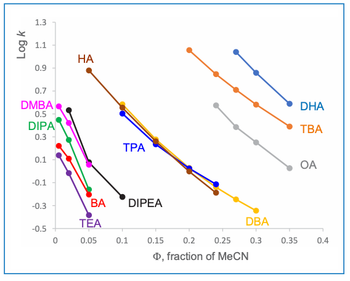
- LCGC North America-03-01-2014
- Volume 32
- Issue 3
Mixed-Mode HPLC Separations: What, Why, and How
The mechanisms of mixed-mode chromatography are explained, with reference to the parameters that are used to optimize selectivity and retention.
Although reversed-phase columns (such as C18) are used in a wide range of applications, they often fail to retain highly polar (or charged) analytes, and offer limited selectivity.
Hydrophilic-interaction chromatography (HILIC) is often used to analyze polar analytes, but it encounters challenges such as increased use of organic solvents, poor solubility of analytes in highly organic media, retention affects created by the sample matrix, and a limitation to the extent to which the retention of hydrophobic analytes can be controlled.
Ion-exchange chromatography can be used to retain charged molecules, but it fails to retain neutral analytes and can show poor selectivity for analytes of the same charge.
A current estimate of the usage of these techniques is reversed phase ~60+%; HILIC or normal phase ~18%; ion exchange ~5%.
The use of mixed-mode stationary phases can offer a solution to some of the problems outlined above and their properties and applications can be summarized as follows:
- Mixed-mode chromatography is a method that uses more than one separation mode; mainly reversed-phase combined with ion-exchange interactions, which allows the retention and separation of both polar and nonpolar analytes in a single analysis.
- The biggest benefit of this approach is that selectivity can be optimized by adjusting mobile-phase ionic strength, pH, or organic solvent. As a result, the selectivity can be finely tuned for the separation of compounds with widely different physico-chemical properties. For example, drug molecules and their counterions may be separated in a single analysis.
- Mixed-mode chromatography requires no ion-pairing agents in the mobile phase for separating highly hydrophilic charged analytes, which simplifies the mobile phase and is compatible with mass spectrometry (MS).
A general schematic for the various approaches to producing mixed-mode stationary phases is shown in Figure 1.
Figure 1: Schematic representation of the various approaches to producing mixed-mode stationary phases.
The mixed-beads approach in Figure 1 is a blend of two different stationary phases into a single column: reversed phase (in black) and ion exchange (in red). Issues with this approach include concerns regarding the batch-to-batch reproducibility and homogeneity of the resulting high performance liquid chromatography (HPLC) columns.
The mixed-ligand approach to mixed-mode stationary phase production was a second-generation product, but again, ensuring the absolutely reproducibility and homogeneity of the surface is problematic.
The embedded and tipped ligands are a third-generation approach to mixed-mode phases and produce homogeneous and reproducible mixed-mode phases. The position of the ion-exchange group within the bonded phase ligand dictates the relative strength of the hydrophobic and electrostatic interactions and the embedded ligand can be described as an ion-exchange–modified reversed-phase column and the tipped ligand as a reversed-phase–modified ion-exchange column.
The zwitterionic ligand is a fourth-generation approach to mixed-mode separations in which both anionic and cationic functional groups are included in each ligand and the strength and position of the ion-exchange moieties can be altered to affect the selectivity of each ligand towards various analytes.
In mixed-mode separations, the hydrophobic moieties of analyte molecules are retained by interaction with the hydrophobic parts of the bonded ligand, and the charged groups are either retained or repelled by the ion-exchange groups on the stationary phase surface. There are several ways to control retention and selectivity with mixed-mode phases, as one might imagine.
The amount of organic modifier can be altered to affect changes in retention and selectivity of the separation, primarily by changing the hydrophobicity of the eluent, as would be typical for a reversed-phase separation.
Eluent pH can also be used to alter selectivity and retention, and the pH will affect not only the degree of ionization of the analyte molecule, but also the extent of the surface charge if weak anion- or cation-exchange ligands are used. The ionic strength of the eluent can be used to alter the separation characteristics, and ionic-strength gradients are often used to increase the elution strength of the eluent with respect to the electrostatic interactions between analytes and the stationary phase surface.
The nature of mixed-mode stationary phases offer several possibilities to "tune" the selectivity of a separation and as such offer an important tool in the analytical armory for anyone dealing with highly polar analytes or analytes whose physicochemical properties differ widely.
Articles in this issue
almost 12 years ago
Peaks of Interestalmost 12 years ago
LC Method Scaling, Part II: Gradient Separationsalmost 12 years ago
In-Capillary Sample Concentration in CEalmost 12 years ago
The Storage and Use of Gases for Gas Chromatographyalmost 12 years ago
Vol 32 No 3 LCGC North America March 2014 Regular Issue PDFNewsletter
Join the global community of analytical scientists who trust LCGC for insights on the latest techniques, trends, and expert solutions in chromatography.




